UNITED STATES
SECURITIES AND EXCHANGE COMMISSION
Washington, D.C. 20549
SCHEDULE 14A
(Rule 14a-101)
INFORMATION REQUIRED IN PROXY STATEMENT
Proxy Statement Pursuant to Section 14(a) of
the Securities Exchange Act of 1934 (Amendment No. )
|
Filed by the Registrant x |
|
|
|
Filed by a Party other than the Registrant o |
|
|
|
Check the appropriate box: |
|
o |
Preliminary Proxy Statement |
|
o |
Confidential, for Use of the Commission Only (as permitted by Rule 14a-6(e)(2)) |
|
o |
Definitive Proxy Statement |
|
x |
Definitive Additional Materials |
|
o |
Soliciting Material under §240.14a-12 |
|
|
|
QUALCOMM INCORPORATED |
|
(Name of Registrant as Specified In Its Charter) |
|
|
|
|
|
(Name of Person(s) Filing Proxy Statement, if other than the Registrant) |
|
|
|
Payment of Filing Fee (Check the appropriate box): |
|
x |
No fee required. |
|
o |
Fee computed on table below per Exchange Act Rules 14a-6(i)(1) and 0-11. |
|
|
(1) |
Title of each class of securities to which transaction applies: |
|
|
|
|
|
|
(2) |
Aggregate number of securities to which transaction applies: |
|
|
|
|
|
|
(3) |
Per unit price or other underlying value of transaction computed pursuant to Exchange Act Rule 0-11 (set forth the amount on which the filing fee is calculated and state how it was determined): |
|
|
|
|
|
|
(4) |
Proposed maximum aggregate value of transaction: |
|
|
|
|
|
|
(5) |
Total fee paid: |
|
|
|
|
|
o |
Fee paid previously with preliminary materials. |
|
o |
Check box if any part of the fee is offset as provided by Exchange Act Rule 0-11(a)(2) and identify the filing for which the offsetting fee was paid previously. Identify the previous filing by registration statement number, or the Form or Schedule and the date of its filing. |
|
|
(1) |
Amount Previously Paid: |
|
|
|
|
|
|
(2) |
Form, Schedule or Registration Statement No.: |
|
|
|
|
|
|
(3) |
Filing Party: |
|
|
|
|
|
|
(4) |
Date Filed: |
|
|
|
|
|
|
|
|
On February 21, 2018, Qualcomm Incorporated (“Qualcomm”) posted the following material to www.qcomvalue.com.
TRANSCRIPT OF “QUALCOMM LEAD DIRECTOR ON BROADCOM TAKEOVER BID”
FROM CNBC’S “SQUAWK ON THE STREET”
DAVID FABER AND TOM HORTON
FEBRUARY 20, 2018
David Faber: Let’s talk to Qualcomm’s lead director, he’s Tom Horton. Some people may remember you, of course, running American Airlines— and a number of other things as well. Nice to have you here.
Tom Horton: Great to be here.
David Faber: Why did the Board decide to increase the offer to $127.50 for NXP when you do have somebody like Hock Tan saying it’s a failed business model that you have in general?
Tom Horton: Well, of course, we totally disagree with all of that. The deal for NXP is strategically very important for Qualcomm, accelerating our growth into automotive, IoT, security, building on our 5G strength and roll out. Strategically made a lot of sense. We did the deal initially at $110 a share. I think a lota of folks viewed that as— you know, a very favorable price for Qualcomm. The Company has continued to do very well, earnings are up 20% from the time we did the deal.
David Faber: That’s NXP you’re talking about.
Tom Horton: NXP’s earnings.
David Faber: Right.
Tom Horton: And we raised the bid 16%. So it’s actually at a lower multiple than— the deal when it was originally announced.
David Faber: Right.
Tom Horton: So we think it makes a lot of sense strategically and financially.
David Faber: As I had been reporting for many, many months, the deal was not going to get done at $110.
Tom Horton: We noted that.
David Faber: Yeah. And in part because of its unique structure, Dutch company, a tender offer as opposed to the way other things go. Is it done now in your opinion? Is this thing going to close on March 5th? And what about China? We’re still waiting for the approvals from the antitrust authorities.
Tom Horton: Well, and we don’t know when we’ll get the approval from the Chinese antitrust authorities. They’re a very competent regulator and they typically tend to follow the others. We’ve got eight regulatory bodies around the world that have already approved it. So we think we’ll get approval. But we have to wait and see on that. In terms of the shareholders— you know, we’ve got 28% of them signed up. We lowered the minimum tender threshold from 80% to 70%. So we think— from a shareholder perspective it’s buttoned up.
David Faber: And on China on timing, you just have— you have nothing to offer at this point?
Tom Horton: Well, we’ll wait and see. You know, it’s the middle of the Chinese New Year, so that slowed things down a little bit. But we think after that, we’ll get approval. We’re confident we’ll get approval. We’ve been in constant dialogue with MOFCOM and we think we’ll get approval in short order.
David Faber: March 5th is when the tender offer for NXP expires. March 6th is currently the vote for your own shareholders to decide who’s going to be on the Board of Directors.
Tom Horton: That’s correct.
David Faber: ISS, the influential advisory firm, came out with their recommendation late Friday in which they said they think four of Broadcom’s nominees should be seated. They went on to say that “Qualcomm’s optimistic vision of the future would likely resonate more effectively amongst shareholders if the company’s track record was more like that of its would-be acquirer, Broadcom.” What do you say when you read something like that?
Tom Horton: Yeah, so obviously we disagree that four directors need to be added to our Board. That obviously is not a majority of the Board. So I think that’s notable. I think what’s interesting about the ISS report is that it agreed with us on many points, which is $82 a share is not adequate value for the Company, the regulatory certainty has not been sufficiently met, and notably, that certainty on NXP was important to Qualcomm and it shareholders. Well, we’ve actually addressed the latter of those and we agree with the first two. So I think that’s important. And I
think, you know, you also need to remember that ISS tends to influence a minority of the shareholders. So I think it’s far from clear as to what effect, if any, that’ll have.
David Faber: Right. Of course the index funds can typically follow them. They are a significant percentage overall of many companies shares. $82’s not enough. The Board is unanimous in that decision. Why?
Tom Horton: Well, if you look at our 2019 earnings projections which are now even more certain than they were before with the completion of the NXP deal around $7 a share. $82 represented 11 to 12 times multiple on that. The semi-conductor average multiple is around 18. Precedent deals around 22. So it’s just not even close to what the value of the Company is. And that’s the Board’s view.
David Faber: And to those who would say that $7 number is really a reach particularly given the ability of the Company to execute over the last few years on its business plan and say that it has failed to do so? What’s your response?
Tom Horton: I completely disagree with that. We’re on the verge of reaping the benefits of all the investments we’ve made in 5G, which is rolling out in a very profound way over the next couple of years. And we’ve just closed up the NXP deal which has $1.50 of accretion inherent in it. So that part of the puzzle has now been put in place.
David Faber: And what about the business model overall? Of course the licensing business where it appears Broadcom has a very different view in terms of how they would run it. Again, to this ISS report only because it very recently came out. They say the assertion that certain customers and regulators might be very receptive to a revamp of Qualcomm’s approach to licensing seems credible.
Tom Horton: Well, it’s not at all clear what the proposal on licensing is from the Broadcom side. And that’s something we’ve tried to address as we’ve spoken with them. But I would say, you know, we have 300 big customers around the world that are signed up to our licensing protocol which, by the way, creates the platform for 5G.
You know, Qualcomm is sort of the engineering and development engine behind wireless technologies around the world, and a lot of customers benefit from that. So a couple years ago we established a protocol for a licensing in China as part of the settlement with the Chinese. And that’s a big part of our business. That’s actually our biggest business. And just recently we signed up Samsung, the largest OEM in the world. So I think it’s— the facts just really belie that assertion
David Faber: And has the debate in the boardroom been robust, would you say? You certainly are, you know, somebody who’s had a lot of experience in those rooms. Are people pushing back? Is there a lot of conversation about these very issues?
Tom Horton: I would say this is a very energetic Board. We have a lot of new Board members on the Board. Our average tenure is around five years. So it’s a very energetic, enthusiastic and fresh perspective Board, if I could put it that way. We’re skeptical. We’re skeptical, I think in a healthy way, of our own plans.
We’re skeptical of others’ plans for the Company in an M&A context. But, you know, it’s one of the reasons, David, that we thought getting the NXP deal done was good in either case. It makes Qualcomm stronger, more diversified, more profitable. It adds $3 billion in EBITDA to Qualcomm. That’s good in either case. Whether we pursue our independent strategy or whether we pursue a combination of Broadcom. It just creates more value for Qualcomm.
Broadcom’s Proposed Acquisition of Qualcomm: A Bad Deal for Innovation and Consumers OPINION By Lisa Kimmel February 20, 2018 Antitrust policy in the United States and around the world is, ideally, a flexible framework, grounded in economics that antitrust authorities apply to protect consumers from anticompetitive business activity. While this flexible fact-based approach has its virtues, it undoubtedly creates a degree of uncertainty and discretion that companies can exploit to their economic advantage, seeking to use antitrust complaints for added leverage in supplier negotiations or to knock down rivals who have a superior product. Well-meaning antitrust authorities, grappling with complex facts and economics, and naturally attracted to exciting high-profile cases, risk finding themselves unwitting accomplices. Complaining parties will seek out the most sympathetic jurisdiction — often those that may lack fundamental due process protections and that use industrial policy in place of economically sound antitrust analysis — and it can spread across the globe from there. Particularly in the technology sector, business disputes now routinely breed global antitrust combat, with innovation and long-run consumer welfare sometimes the losers. Though certainly not alone among successful U.S. technology companies, in recent years Qualcomm has found itself enmeshed in just this kind of global antitrust warfare, facing complaints and investigations in multiple jurisdictions, including the United States and South Korea. Though the allegations and theories of harm differ, most focus at least in part on Qualcomm’s licensing model. Qualcomm has committed to various standards-development organizations that it will license its essential 2G, 3G and 4G patents on fair, reasonable and nondiscriminatory (“FRAND”) terms. Qualcomm has had FRAND commitments in place for more than two decades. And for more than two decades it has followed industry practice and licensed its essential patents to end-device manufacturers, like smartphone and tablet makers, rather than upstream component manufacturers, like other chip suppliers. There are many legitimate procompetitive reasons why end-device licensing has been the norm in the smartphone sector, including primarily the nature of the products and technologies. Many essential patents cover technology that optimizes the wireless system and network and is not narrowly housed in any single component. Requiring essential patent owners to license upstream component makers would greatly increase the transaction costs and complexity of licensing negotiations, making it more difficult for essential patent owners to receive an adequate reward for their investments in innovation. And to what end? Qualcomm’s licensing model is not likely to harm chipset rivals because Qualcomm does not assert its patents against component makers. These suppliers are free to compete unencumbered on price and quality. But under the patent laws, Qualcomm cannot provide licenses to component makers without at least partially exhausting its rights at an artificially low level and interfering with its ability to engage in efficient portfolio licensing at the end-device level.
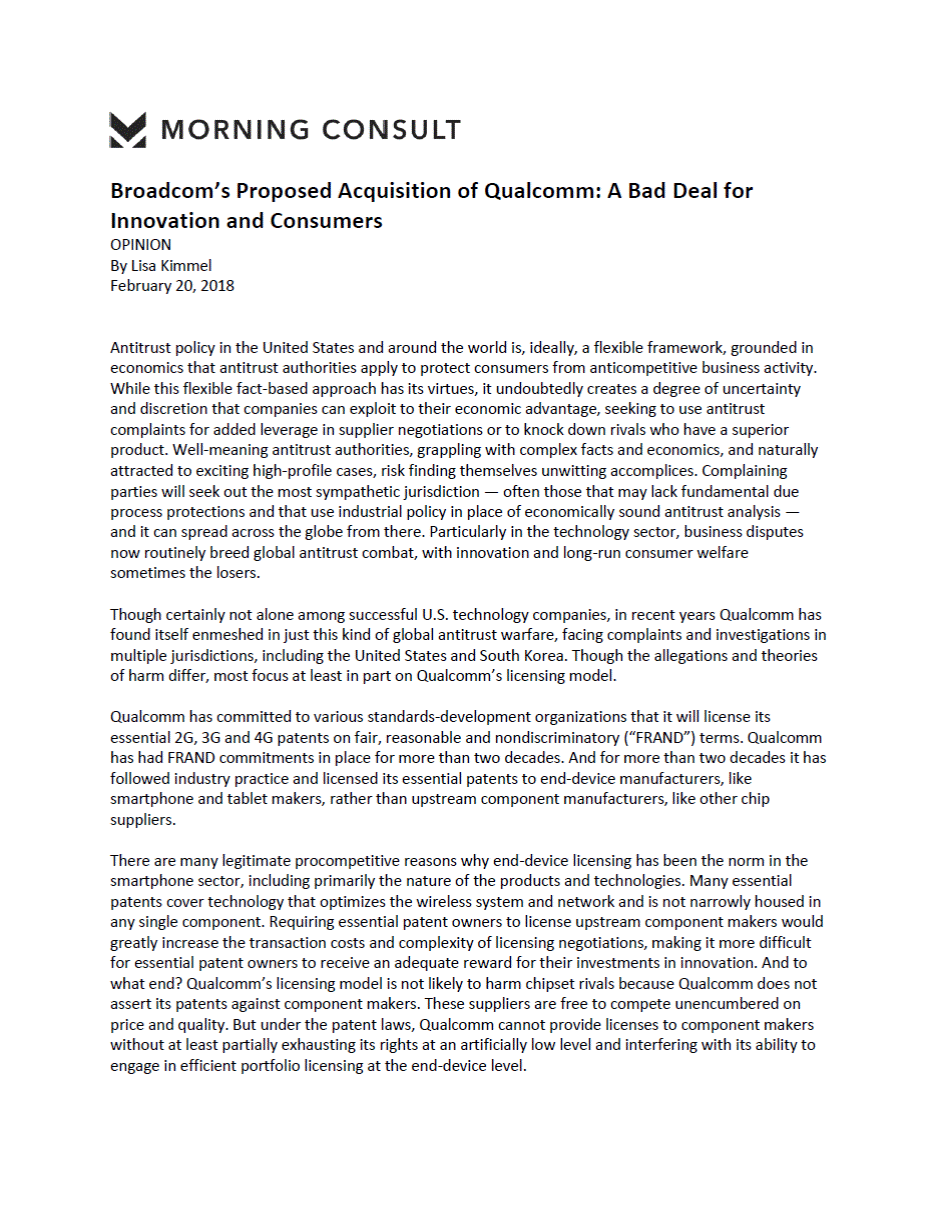
The smartphone sector has thrived under the end-device licensing model that is now under attack by firms who primarily implement rather than contribute technology to standards. But implementers, pursuing their own profit motives, understand that component level licensing will make it difficult, if not impossible, for essential patent owners to fairly monetize their intellectual property and will lead to artificially lower royalty payments. They have been engaged in a sustained effort to persuade antitrust enforcers that firms like Qualcomm that engage in efficient end-device portfolio licensing are somehow misbehaving. The investigations and enforcement actions against Qualcomm reflect the success of this sustained lobbying by self-interested implementers. But the environment is plainly shifting. Soon after taking over at the U.S. Department of Justice Antitrust Division, Assistant Attorney General Makan Delrahim announced a course correction in antitrust policy toward the exercise of patent rights — including standard-essential patents subject to a FRAND commitment. In a speech delivered on Nov. 10, 2017, Delrahim stated that antitrust enforcers “have strayed too far in the direction of accommodating the concerns of technology implementers … and perhaps risk undermining incentives for IP creators who are entitled to an appropriate reward for developing break-through technologies.” And just a few weeks later, on Nov. 29, 2017, the European Commission issued a long-awaited communication describing what it considers a preliminary set of “best practices” for essential patent licensing for the 5G/internet of things sectors. Perhaps recognizing that a radical shift in existing practices might derail competition and innovation for the IoT, the commission deleted language from prior drafts recommending component-level licensing in favor of “access for all” — the model Qualcomm follows today. Qualcomm is now the target of a hostile takeover bid by rival chipmaker Broadcom. Broadcom has reportedly indicated that it would abandon Qualcomm’s licensing model, a move that should concern anyone who cares about innovation in the wireless telecommunications sector. Short-term gains to implementers will lead to long-term damage to innovation and consumer welfare. Consumers are likely to suffer more immediate harm as well. Recent economic research indicates that changing from the current end-user licensing model (with royalties set as a percentage of the final device price) to per unit component licensing is likely to increase device prices for consumers, as device makers would face higher incremental costs. Broadcom’s proposed acquisition of Qualcomm faces significant regulatory hurdles — which will result in protracted review and significant distraction to Qualcomm at a critical time in the industry. Anyone looking forward to the next generation of wireless communications and connected devices should hope these two companies remain vigorous competitors, pursuing their separate visions for what tomorrow should look like, for many years to come. Lisa Kimmel is a former attorney advisor to U.S. Federal Trade Commission Chairwoman Edith Ramirez and current senior counsel in the Antitrust Group at Crowell & Moring LLP. The views expressed in this article are her own and do not necessarily represent the views of her firm or any of its clients. Source: https://morningconsult.com/opinions/broadcoms-proposed-acquisition-of-qualcomm-a-bad-deal-for-innovation-and-consumers/
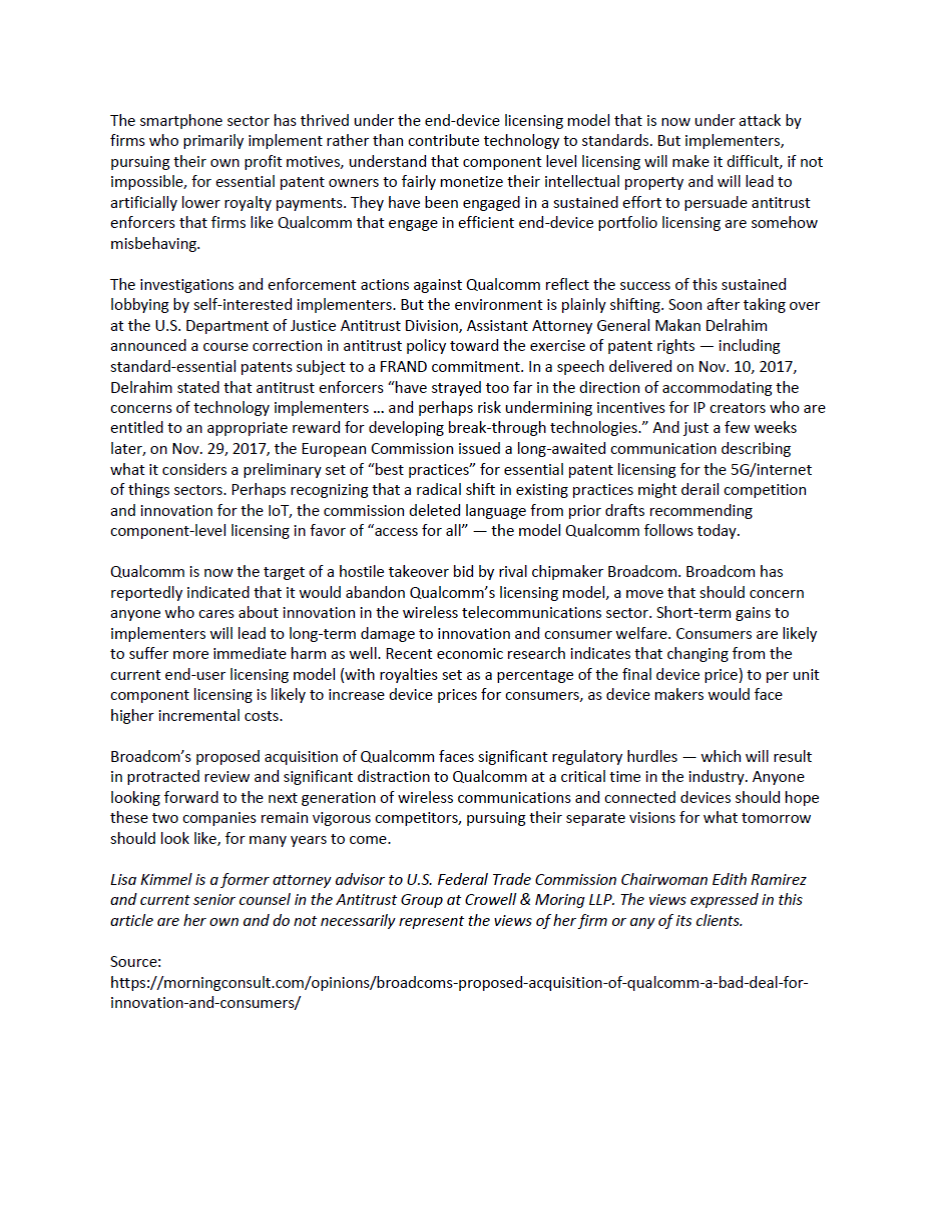
Opinion by Former Senior Government Officials and Leading Antitrust Experts on the Significant Antitrust Risks Posed by Broadcom’s proposed takeover of Qualcomm 20 February 2018 Abstract: There are material regulatory risks associated with any combination of Broadcom and Qualcomm. Given the parties’ competitive positions in WiFi and RFFE products (among others), the complexity of complying with a divestiture demand because of the difficulty the parties will have separating these businesses and selling them to an acceptable buyer, and the real risk that agencies (e .g., China’s MOFCOM) may demand significant restrictions on Broadcom’s post-merger licensing and distribution practices, the transaction presents significant antitrust risk. Based on our experience as former senior government officials and practitioners with significant cross-border antitrust merger review experience, we write to share the significant antitrust risks posed by Broadcom’s proposed takeover of Qualcomm.1 Broadcom’s February 9, 2018 proposed merger agreement states, in relevant part, that: (1) Broadcom agrees to use its “reasonable best efforts” to complete the process; (2) to that end, it is willing to divest Qualcomm’s network (but not mobile) WiFi and Radio Frequency Front-End (RFFE) assets or businesses (excluding integrated products such as Snapdragon) and any other Qualcomm assets, licenses, or other businesses so long as not material; and (3) Broadcom will pay Qualcomm a reverse break-up fee of $8 billion in the event that regulatory approval is not received, assuming that there has been no “material adverse effects” (MAEs) on Qualcomm’s businesses. The proposed agreement further provides for the following limitations on Qualcomm during the period between signing and closing: (1) prohibitions on initiating litigation, including to enforce its intellectual property rights (IPRs) against infringers who refuse to pay; (2) prohibitions on entering into any license agreement or materially amending existing agreements; and (3) prohibitions on settling existing litigation without Broadcom’s consent. Based on public reports, we also understand that Broadcom has further stated that it is now willing to commit to additional divestitures, including its own connectivity businesses, but has not agreed to commit to accept conduct remedies such as prohibitions on bundling or tying products.2 1 Some of the signatories are affiliated with U.S. -based law firms that represent Qualcomm in policy or other matters. Professor Hwang Lee served as an expert for Qualcomm in unrelated Korea Fair Trade Commission matters. 2 According to press: “In the meeting this week, Singapore -based Broadcom was willing to make certain divestitures to satisfy antitrust regulators, but was still resistant to ‘other commitments that could be expected’ to be required by government regulatory bodies, Qualcomm said.” Greg Roumeliotis & Diane Bartz, Qualcomm Says Open to More Deal Talks With Broadcom Following Meeting, US NEWS (Feb. 16, 2018, 8:21 am), https://money.usnews.com/investing/news/articles/2018 -02-16/qualcomm-says-open-to-talks-with-broadcom-for-better-offer. However, in its filing to the SEC yesterday, Broadcom reiterated its willingness to accept only those limited divestitures set forth in its original proposed merger agreement. Qualcomm Incorporated, Proxy Statement (filed by Broadcom Limited) (Schedule 14A Information) (Feb. 20, 2018). -1-
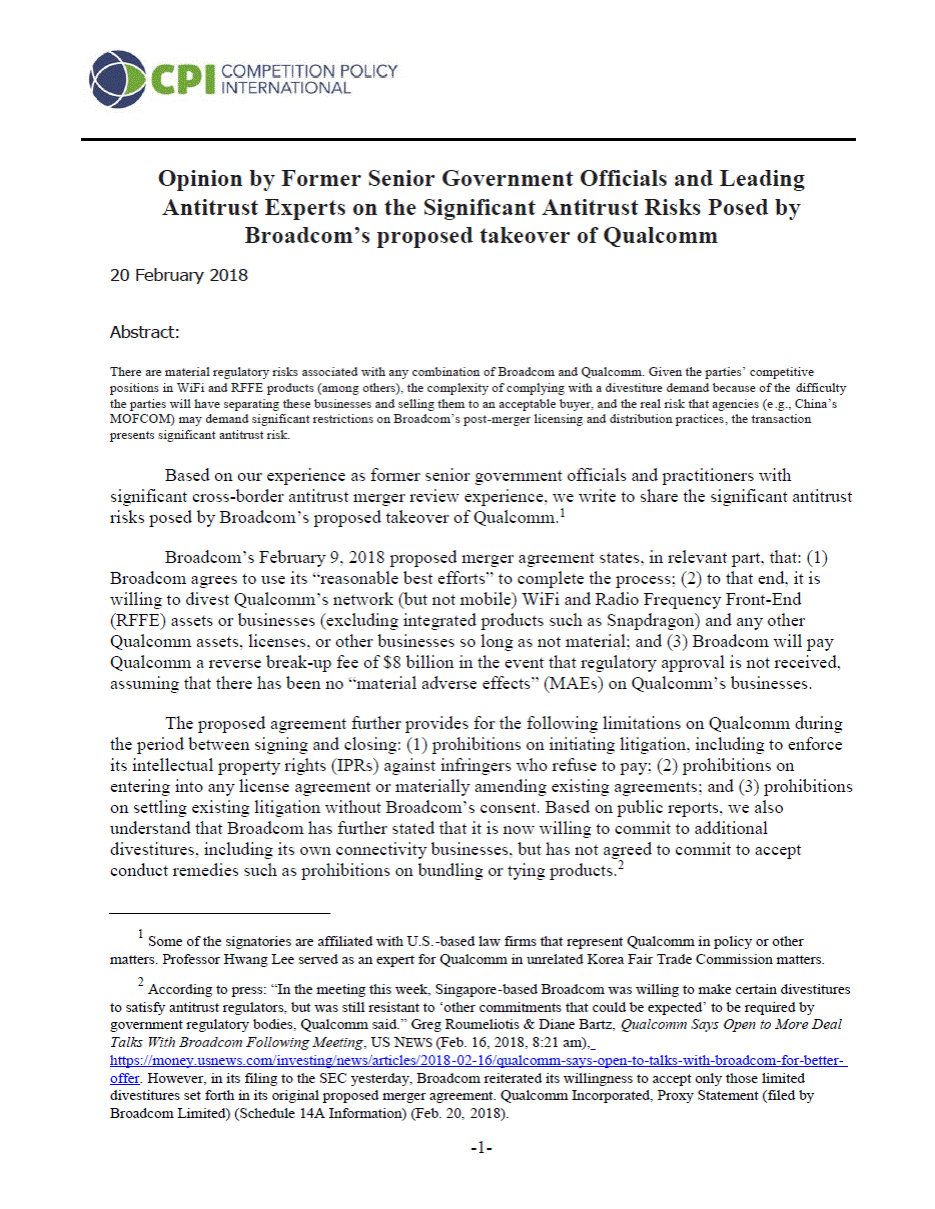
Given these terms, shareholders should be aware of the following: (1) the real risk that foreign antitrust agencies will impose onerous remedies that either restrict the parties’ ability to engage in certain conduct or require them to take specific actions; (2) the prior actions of antitrust agencies in rejecting proposed divestiture buyers that do not have both the ability and incentive to compete with the combined entity on day 1 and to take the technologies to the next generation; (3) that similar complex cross-border deals have taken 18+ months to gain regulatory approval, especially where—as here—approval is required by numerous jurisdictions (here, the United States, the European Union, China, India, Korea, and Taiwan); and (4) the likelihood that Broadcom’s proposed limitations on how Qualcomm can run its business from signing to close violate antitrust “gun-jumping” rules, which alone could be the subject of a separate investigation by the U.S. Federal Trade Commission and others. With respect to conduct remedies, there are countless examples showing that regulators can and do impose substantial conduct remedies, including those that could amount to an MAE, and that may not be merger-specific. These include: Interoperability requirements (e.g., the European Commission’s (EC’s) Intel/McAfee and Intel/Altera decisions requiring the companies to take specific steps to ensure that their products interoperated with competitors’ products); Prohibitions on tying or bundling products (e.g., the EC’s Intel/McAfee and China’s Ministry of Commerce’s Merck/AZ); Prohibitions on seeking or enforcing injunctive relief on FRAND-assured SEPs (e.g., MOFCOM’s Microsoft-Nokia); Price caps (e.g., MOFCOM’s Microsoft-Nokia and Merck-AZ imposing royalty caps on IPRs); Requirements to invest in specific amounts of research and development (e.g., MOFCOM’s Samsung/Seagate, requiring Seagate to invest at least $800 million a year for three years in innovation to ensure that the company would bring more innovative products and solutions to consumers); Non-merger-specific remedies to address other concerns the agencies may have already or discover during the review process (e.g., distribution-related remedies imposed by MOFCOM in ABI-SABMiller); and -2-
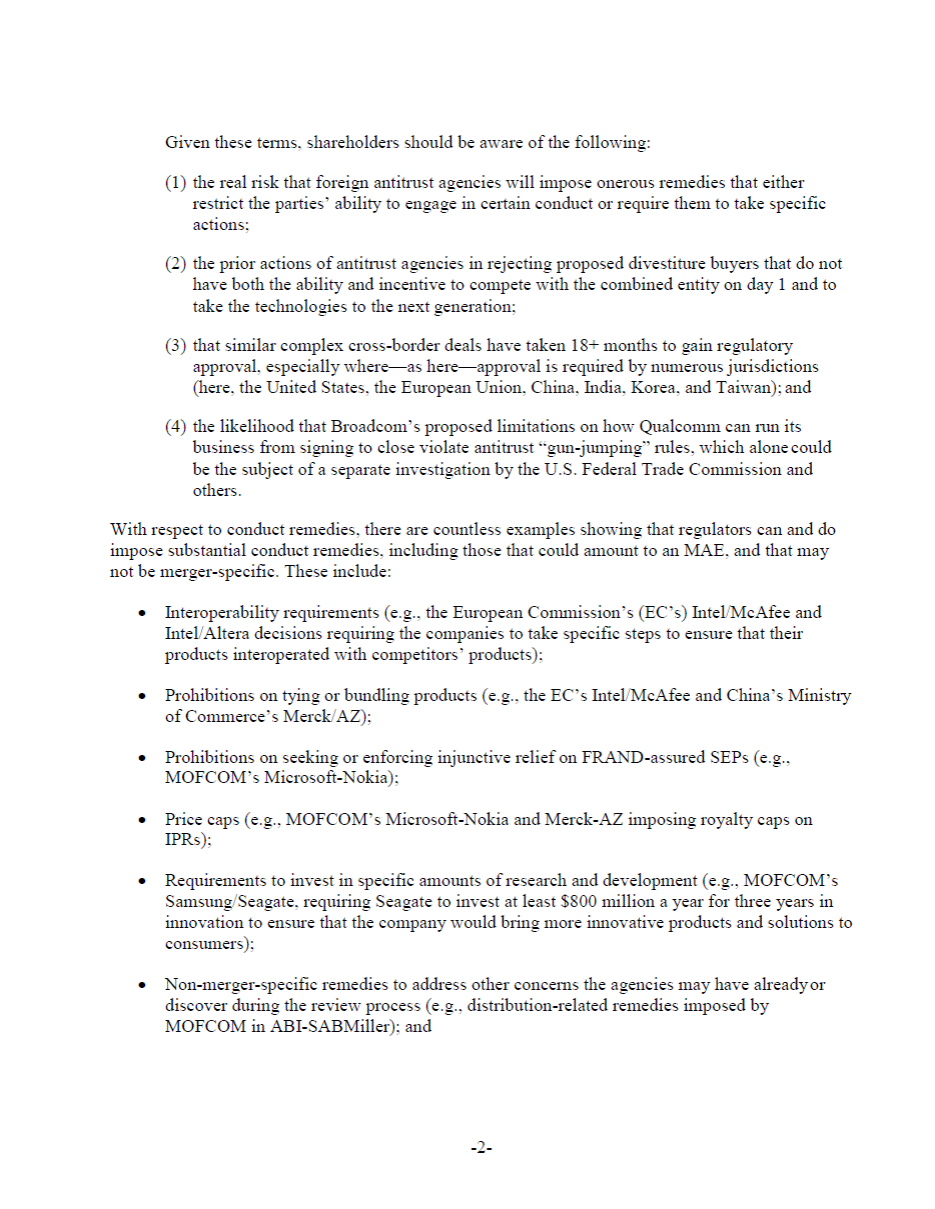
Other non-merger specific remedies to protect domestic champions (e.g., in Google/Motorola, MOFCOM required Google to maintain Android as open and to continue to provide Android to Chinese manufacturers on an expeditious basis). The real risk posed by these types of remedies generally requires deal protection for shareholders, including a “hell-or-high-water clause” (i.e., do whatever is necessary to get the deal done), or at least defining the MAE provision so as to exclude remedies that may be required by antitrust regulators. Such protections ensure that a buyer cannot walk away from the deal at any point during or after a protracted regulatory review period, particularly given the likely disruption caused to targets (here, Qualcomm) during such a review period. With respect to divestitures, antitrust agencies will require that any divestiture remedies fully replace the loss of Qualcomm’s competitive pressure in the market, i.e., any remedy must make competition “whole” in the sense that it must put another competitor in a position to compete as effectively against Broadcom as Qualcomm does today (and likely into the future). And, of course, any divestiture transaction would itself have to be reviewed for antitrust and national security issues. Prior agency precedent makes it clear that agencies require divestiture buyers have the incentive and ability to compete immediately, and continue competing into the future. Applied Materials/Tokyo Electron (2015) was abandoned after the U.S. Department of Justice (DOJ) rejected the parties’ tool-line (product) divestitures as insufficient to preserve existing competition with respect to “the development of equipment for next-generation semiconductors” on the grounds that proposed buyer was not already focused on the product-line and did not have the same capacity to innovate. The DOJ was also concerned that the transaction would have combined “the two largest competitors with the necessary know-how, resources and ability to develop and supply” the technology products at issue. As DOJ’s then Chief Economist observed, “[n]aturally, the Antitrust Division would be . . . wary of the ability of any remedy to replicate [the] competitive dynamic” and DOJ ultimately concluded “that replicating the competitive significance of one of the most innovative companies in a sector that is virtually synonymous with innovation would be exceptionally challenging.”3 The U.S. antitrust agencies have also rejected proposed divestiture buyers because they could not effectively compete on Day 1. In Sysco Corp./US Foods Inc., the FTC rejected divestiture of facilities and sued to block the transaction; in Staples Inc./Office Depot Inc., the FTC rejected divestiture of significant contracts, and sued to block the transaction; and in Baker Hughes/Haliburton, the DOJ rejected divestiture package because, among other things, the discreet assets were insufficient for remedy. 3 Nicholas Hill, Nancy L. Rose, & Tor Winston, Economics at the Antitrust Division 2014-2015: Comcast/Time Warner Cable and Applied Materials/Tokyo Electron, 46 REV. IND. ORGAN. 425, 432 (2015), https://economics.mit.edu/files/12988. -3-
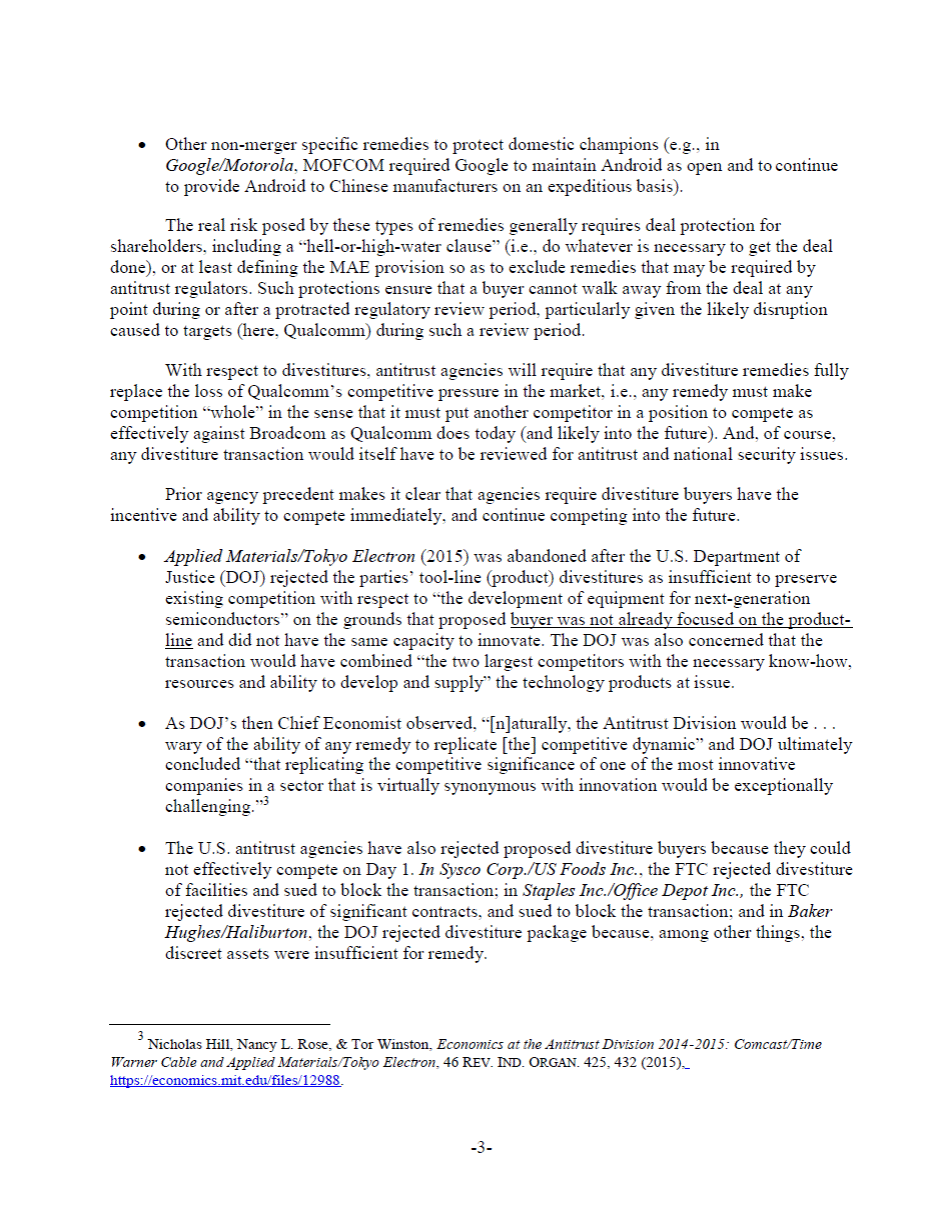
With respect to likely review timing, recent deals suggest that the regulatory approval process is likely to take 18+ months (see e.g., Qualcomm/NXP—15+ months and counting despite the lack of direct competition between the parties; Penn State Hershey/Pinnacle—abandoned by the parties in 2016 after a 28 month review period; Advocacy Health Care/NorthShore University Health System—abandoned in 2017 after a 30 month review period; Halliburton/Baker Hughes— abandoned in 2016 after a 19 month review period; DuPont/Dow Chemical and Abbott Laboratories/Alere—each taking 20 months to gain necessary approvals. Indeed, the recent proposed merger of the #1 and #3 global suppliers of semiconductor manufacturing equipment was abandoned after an 18-month review period. In short, there are material regulatory risks associated with any combination of Broadcom and Qualcomm. In the United States, Europe, and China, in particular, this deal raises significant issues that will require a substantial amount of time and effort for global regulatory agencies to resolve. Given the parties’ competitive positions in WiFi and RFFE products (among others), the complexity of complying with a divestiture demand because of the difficulty the parties will have separating these businesses and selling them to an acceptable buyer, and the real risk that agencies (e.g., MOFCOM) may demand significant restrictions on Broadcom’s post-merger licensing and distribution practices, the transaction presents significant antitrust risk. Susan Creighton Partner, Wilson Sonsini Goodrich & Rosati, P.C. Former Director, Federal Trade Commission, Bureau of Competition Lisa Kimmel Senior Counsel, Crowell & Moring LLP Former Attorney Advisor on Antitrust and Competition Policy, Federal Trade Commission Miguel de la Mano Executive Vice President, Compass Lexecon Former Deputy Chief Economist, DG Competition, EU Commission Hwang Lee Professor, Korean University School of Law Chairman, Advisory Committee for Policy, Ministry of Foreign Affairs and Trade Former KFTC Official and Member of the Research Counsel for the Justices of the Supreme Court of Korea Herbert Hovenkamp James G. Dinan University Professor University of Pennsylvania Author of Antitrust Law: An Analysis of Antitrust Principles and Their Application Jim Rill Partner, Baker Botts LLP Former Assistant Attorney General, US Department of Justice, Antitrust Division -4-

He Jing Senior Consultant, AnJie Law Firm (Beijing) Advisor for the LL.M program at both Peking University School of IP and Tsinghua University School of Law Steve Weissman Partner, Baker Botts LLP Former Deputy Director, Federal Trade Commission, Bureau of Competition Joshua Wright Senior Of Counsel, Wilson Sonsini Goodrich & Rosati, P.C. Former Commissioner, Federal Trade Commission This article was first published by Competition Policy International Inc. on 20 February, 2018. All rights reserved. A link to the original article can be found at https://www.competitionpolicyinternational.com/opinion-by-former-senior-government-officials-and-leading-antitrust-experts-on-the-significant-antitrust-risks-posed-by-broadcoms-proposed-takeover-of-qualcomm/ -5-
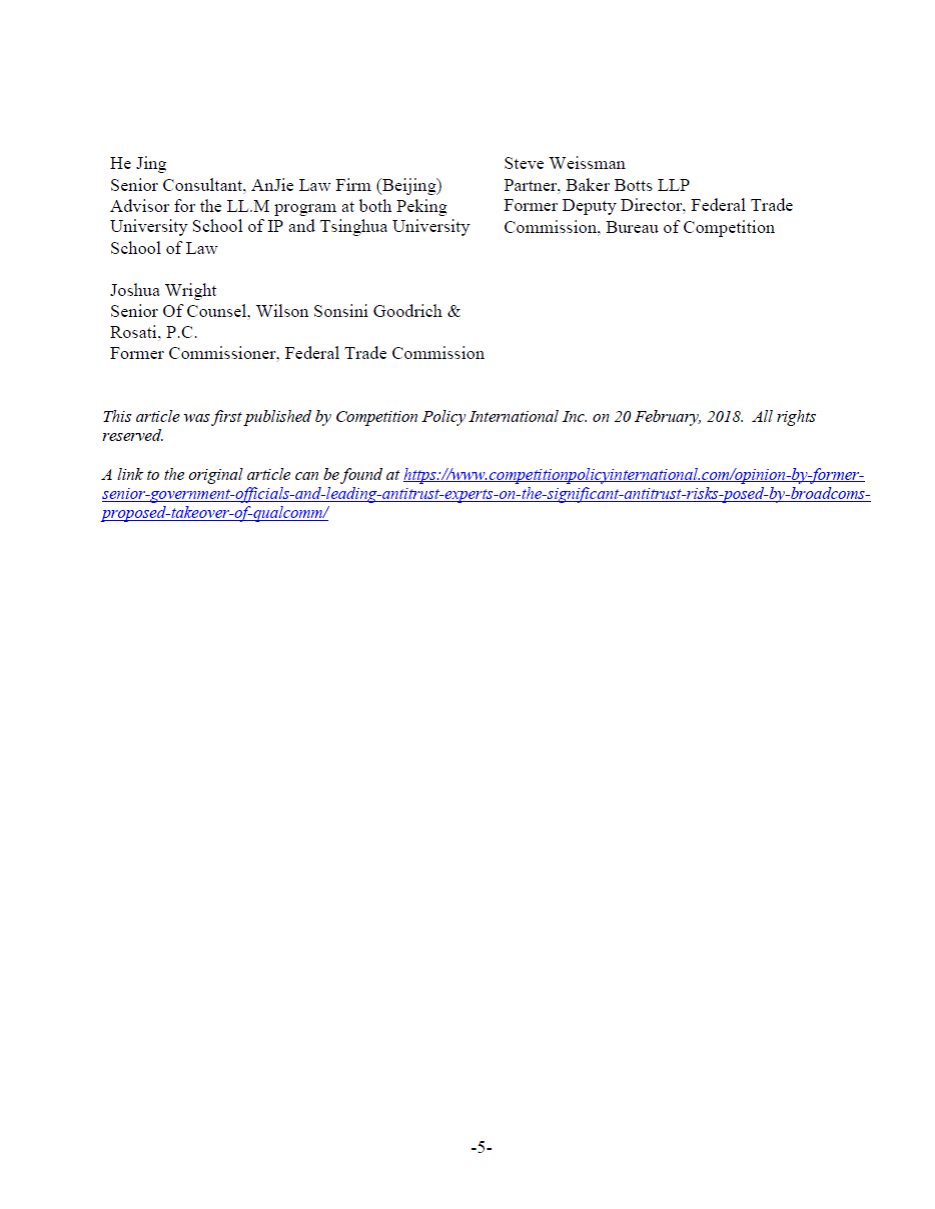
Additional Information
Qualcomm has filed a definitive proxy statement and WHITE proxy card with the U.S. Securities and Exchange Commission (the “SEC”) in connection with its solicitation of proxies for its 2018 Annual Meeting of Stockholders (the “2018 Annual Meeting”). QUALCOMM STOCKHOLDERS ARE STRONGLY ENCOURAGED TO READ THE DEFINITIVE PROXY STATEMENT (AND ANY AMENDMENTS AND SUPPLEMENTS THERETO) AND ACCOMPANYING WHITE PROXY CARD AS THEY CONTAIN IMPORTANT INFORMATION. Stockholders may obtain the proxy statement, any amendments or supplements to the proxy statement and other documents as and when filed by Qualcomm with the SEC without charge from the SEC’s website at www.sec.gov.
Certain Information Regarding Participants
Qualcomm, its directors and certain of its executive officers may be deemed to be participants in connection with the solicitation of proxies from Qualcomm’s stockholders in connection with the matters to be considered at the 2018 Annual Meeting. Information regarding the identity of potential participants, and their direct or indirect interests, by security holdings or otherwise, is set forth in the proxy statement and other materials to be filed with the SEC. These documents can be obtained free of charge from the sources indicated above.
Cautionary Note Regarding Forward-Looking Statements
Any statements contained in this website that are not historical facts are forward-looking statements as defined in the U.S. Private Securities Litigation Reform Act of 1995. Additionally, statements regarding operating results for future years, growth in operating results and the factors contributing to future operating results; the resolution of licensing disputes and the impact and timing thereof; expected market, industry, geographic and organic growth and trends; future serviceable addressable market size and growth; anticipated contributions from and growth in new opportunities; benefits from planned cost reductions; technology and product leadership and trends; Qualcomm’s positioning to benefit from any of the above; potential benefits and upside to Qualcomm’s stockholders related to any of the above; and the regulatory process and regulatory uncertainty are forward-looking statements. Words such as “anticipate,” “believe,” “estimate,” “expect,” “forecast,” “intend,” “may,” “plan,” “project,” “predict,” “should,” “will” and similar expressions are intended to identify such forward-looking statements. These statements are based on Qualcomm’s current expectations or beliefs, and are subject to uncertainty and changes in circumstances. Actual results may differ materially from those expressed or implied by the statements herein due to changes in economic, business, competitive, technological, strategic and/or regulatory factors, and other factors affecting the operations of Qualcomm. More detailed information about these factors may be found in Qualcomm’s filings with the SEC, including those discussed in Qualcomm’s most recent Annual Report on Form 10-K and in any subsequent periodic reports on Form 10-Q and Form 8-K, each of which is on file with the SEC and available at the SEC’s website at www.sec.gov. SEC filings for Qualcomm are also available in the Investor Relations section of Qualcomm’s website at www.qualcomm.com. Qualcomm is not obligated to update these forward-looking statements to reflect events or circumstances after the date of such statements. Readers are cautioned not to place undue reliance on these forward-looking statements, which speak only as of their dates.






